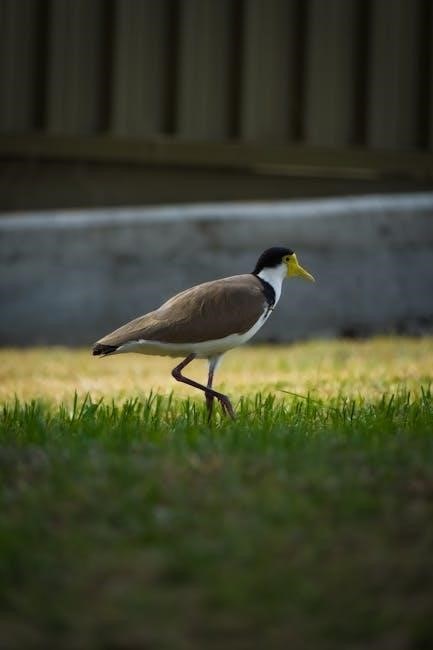Australian birdsong is a unique aspect of the country’s natural heritage, with various species exhibiting distinct vocalisations, making a field guide to Australian birdsong a valuable resource for enthusiasts and researchers alike naturally.
Overview of Australian Field Guides
A field guide to Australian birdsong is an essential tool for bird enthusiasts, providing a comprehensive overview of the country’s avifauna. The guides typically include descriptions of bird species, their habitats, and distributions, as well as information on identification, behavior, and conservation status. Many field guides also feature illustrations or photographs of the birds, making it easier for readers to recognize and identify species. Some guides may focus on specific regions or types of birds, such as waterbirds or birds of prey. The information in these guides is often compiled by experts in the field, including ornithologists and birdwatchers, and is based on the latest research and data. By using a field guide to Australian birdsong, readers can gain a deeper understanding and appreciation of the country’s unique and diverse birdlife, and can also contribute to conservation efforts by learning about the importance of protecting bird habitats and populations.

History of Australian Field Guides
Early Australian field guides emerged in the 1930s, with notable publications shaping the country’s ornithological landscape gradually over time with new editions and updates naturally.
Neville Cayley’s What Bird is That
Neville Cayley’s What Bird is That, published in 1931, was a pioneering work in Australian ornithology, providing a comprehensive guide to the country’s bird species. The book featured illustrations and descriptions of various birds, making it a valuable resource for bird enthusiasts and researchers. Although the illustrations were limited by modern standards, the book remained a best seller for several decades. As a foundational text, What Bird is That paved the way for future field guides, including those focused on birdsong. The book’s impact on Australian ornithology is still recognized today, with many considering it a seminal work in the field. With its release, Cayley helped establish a tradition of Australian field guides that continues to grow and evolve, incorporating new research and technologies to better understand and appreciate the country’s unique bird species and their songs.
Comprehensive Guides to Australian Birds
Guides like The Working List of Australian Birds provide detailed information on species, habitats, and distributions, supporting birdsong research and conservation efforts naturally always.
The Working List of Australian Birds
The Working List of Australian Birds, published by BirdLife Australia, is a comprehensive resource that lists over 2,000 species of birds found in Australia, including subspecies. This list is regularly updated to reflect new discoveries and changes in taxonomy. The list is an essential tool for researchers, conservationists, and bird enthusiasts, providing a standardized reference point for identifying and classifying Australian bird species. The Working List of Australian Birds is also used to inform conservation efforts and to track changes in bird populations over time. By providing a detailed and accurate account of Australia’s avifauna, the Working List of Australian Birds supports the development of effective conservation strategies and promotes a greater understanding of the country’s unique birdlife. The list is widely regarded as a authoritative reference and is widely used by birders and researchers alike;

Popular Australian Birdsong Recordings
Recordings by Andrew Skeoch are highly regarded, featuring iconic species and their songs, providing a valuable resource for enthusiasts and researchers of Australian birdsong naturally every day.
Favourite Australian Birdsong by Andrew Skeoch
Favourite Australian Birdsong by Andrew Skeoch is a notable collection of birdsong recordings, featuring a range of iconic species, including the Rufous Whistler, Grey Shrike-thrush, and Scarlet Robin, among others. The recordings provide a unique insight into the diverse vocalisations of Australian birds, showcasing their complexity and beauty. With a total of ten tracks, the collection offers a comprehensive representation of Australian birdsong, highlighting the country’s rich avifaunal heritage. The recordings have been well-received by bird enthusiasts and researchers alike, and are considered a valuable resource for those interested in Australian birdsong. The collection is a testament to Andrew Skeoch’s dedication to capturing and preserving the sounds of Australian birds, and his contribution to the field of birdsong research is highly regarded. The recordings are a valuable addition to any field guide to Australian birdsong.

Recent Editions of Field Guides
Recent editions of field guides feature updated species lists and revised classifications, enhancing the accuracy of Australian birdsong identification and research naturally always.
Field Guide to the Birds of Australia Ninth Edition
The ninth edition of the Field Guide to the Birds of Australia is a comprehensive resource, featuring updated information on Australian birdsong and species identification. This edition includes extensive revisions, incorporating new research and data on bird behaviour and habitats. The guide is designed to be user-friendly, with colour illustrations and maps to aid in identification. The ninth edition is a substantial revision of previous editions, with attractive design improvements and additional text on recent Australian vagrants. The guide is an essential tool for birdwatchers, researchers, and enthusiasts, providing a thorough understanding of Australian birdsong and its various species. With its detailed information and user-friendly format, the ninth edition is a valuable resource for anyone interested in Australian birdsong and bird identification, making it a must-have for both beginners and experienced bird enthusiasts alike naturally.

Research on Australian Birdsong
Researchers study Australian birdsong to understand its complexities and patterns in various species naturally.
Causes of the Latitudinal Gradient in Birdsong Complexity
The study of birdsong complexity in relation to latitude is a fascinating area of research, with scientists attempting to understand the underlying causes of this phenomenon. According to a study by Singh and Price, the latitudinal gradient in birdsong complexity can be attributed to various factors, including climate, habitat, and evolutionary pressures. The research suggests that birds living in areas with more complex habitats, such as tropical regions, tend to have more complex songs. In contrast, birds living in simpler habitats, such as temperate regions, tend to have less complex songs. The study provides valuable insights into the evolution of birdsong and its relationship to environmental factors, shedding light on the intricate patterns of birdsong complexity across different latitudes and habitats, and the findings have significant implications for the field of ornithology and birdsong research.
A field guide to Australian birdsong is essential for understanding and appreciating the country’s diverse bird species and their unique vocalisations naturally every day.
Importance of Australian Field Guides for Birdwatchers
Australian field guides play a crucial role in helping birdwatchers identify and learn about the country’s diverse bird species, with their unique characteristics and vocalisations. The guides provide detailed information on the birds’ habitats, behaviors, and distributions, making it easier for enthusiasts to locate and observe them. Additionally, the guides often include high-quality images and illustrations, which aid in the identification process. Many field guides also include audio recordings of the birds’ songs and calls, allowing birdwatchers to familiarize themselves with the different vocalisations. Overall, Australian field guides are an essential tool for birdwatchers, providing them with the knowledge and skills necessary to appreciate and understand the country’s rich avifauna. By using these guides, birdwatchers can enhance their experience and contribute to the conservation of Australia’s unique bird species. The guides are a valuable resource for both beginners and experienced birdwatchers.